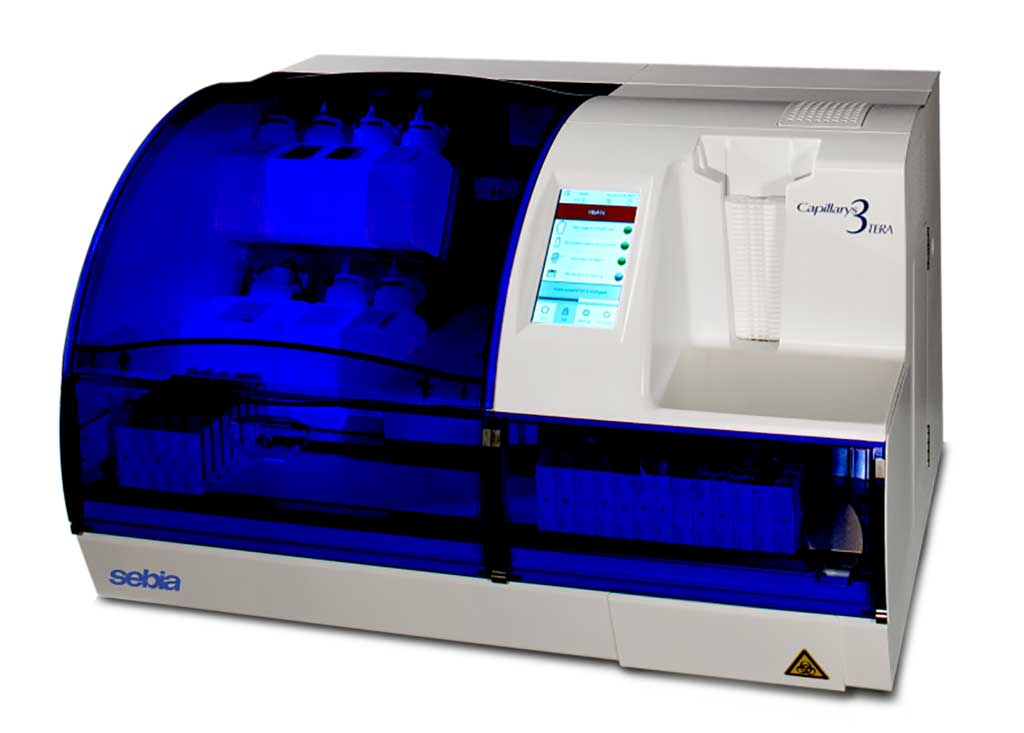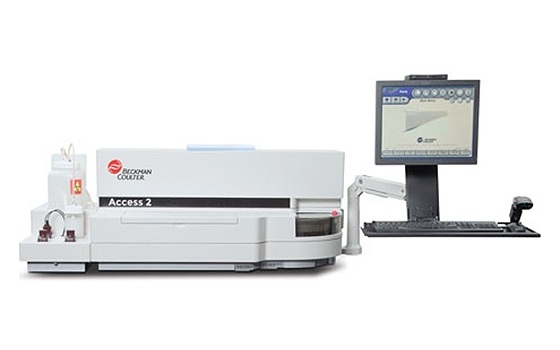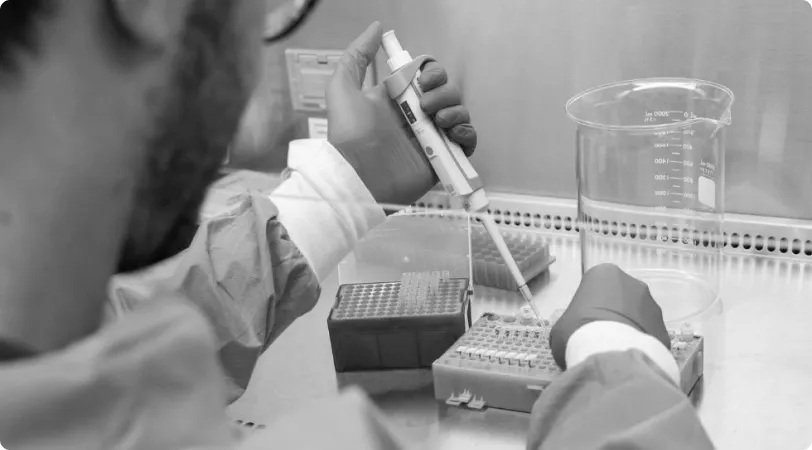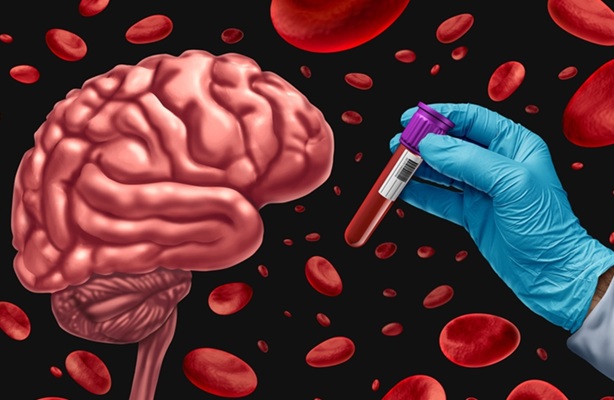Gel and Capillary Electrophoresis Compared for Human Proteins
|
By LabMedica International staff writers Posted on 12 May 2021 |

Image: The Capillarys 3 TERA is an automated analyzer based on capillary zone electrophoresis and UV detection for the quantitative analysis of Hba1c, proteins (serum and urine), immunotyping (serum and urine), and carbohydrate deficient transferrin (Photo courtesy of Sebia)
The electrophoresis of serum proteins remains a laboratory cornerstone for the diagnosis and monitoring of patients with plasma cell disorders, such as monoclonal gammopathy of undetermined significance, multiple myeloma, Waldenström macroglobulinemia, and AL amyloidosis.
Gel electrophoresis remains the method used by most clinical laboratories in the USA. However usage of gel electrophoresis is gradually decreasing while that of capillary electrophoresis is increasing. More recently, analysis of liquid media by capillary electrophoresis was developed and applied to the analysis of serum proteins for clinical purposes.
Laboratory Immunologists at The Johns Hopkins School of Medicine (Baltimore, MD, USA) tested all serum samples analyzed by the immunology laboratory over the course of eight days for routine clinical purposes during the months of October and November 2019, totaling 304 sera. There were 160 females (62 ± 16 years, range 19 -95) and 144 males (65 ± 14 years, range 23-97), with no significant difference in age according to sex.
Sera were first ran using the system currently in use, which consists of a thin-layer agarose gel, HYDRAGEL 30 Protein (E) (Sebia, Lisses, France) and the Sebia Hydrasys 2 semi-automated analyzer. Sera were then assayed on the Sebia Capillarys III TERA automated analyzer using CAPI 3 Protein (E) reagents. Serum immunofixation electrophoresis (SIFE) was performed in 214 of the total 304 sera because already ordered by the provider for most cases. Sera were pre-diluted according to the immunoglobulin G, A, and M concentrations, and then ran on the immunofixation system currently in use, which consists of a thin-layer agarose gel (HYDRAGEL IF 2/4, from Sebia) and the Hydrasys 2 semi-automated analyzer.
The scientists reported that Gel and capillary estimated the concentration of albumin, gamma region, and M-spikes nearly perfectly, and that of beta, alpha-2, and alpha-1 regions with excellent correlation. The two systems classified concordantly 268 of 304 sera (88% agreement) as having no, one, or two M-spikes, but differed in the remaining 36 sera (12%). Gel electrophoresis correctly identified M-spikes in 82 of 112 sera that were shown to have monoclonal band(s) by immunofixation (73% sensitivity), and correctly did not reveal M-spikes in 97/102 sera that had no immunofixation bands (95% specificity). Capillary achieved slightly higher sensitivity (85/112, 76%) and slightly lower specificity (94/102, 92%), but the two areas under the ROC curves were nearly identical at 0.84.
The authors concluded that Gel and capillary electrophoresis systems perform similarly to estimate the concentration of serum protein fractions and detect M-spikes. The Capillarys system has the disadvantages of a higher equipment cost and requiring a greater sample volume. On the other hand, Capillarys requires less involvement of laboratory technicians, offers a faster turn-around time, identifies the specimens they are being analyzed, does not depend upon the chemicals needed to stain and destain the gels, and is more amenable to remote reporting. The study was published on April 29, 2021 in the journal Practical Laboratory Medicine.
Related Links:
The Johns Hopkins School of Medicine
Sebia
Gel electrophoresis remains the method used by most clinical laboratories in the USA. However usage of gel electrophoresis is gradually decreasing while that of capillary electrophoresis is increasing. More recently, analysis of liquid media by capillary electrophoresis was developed and applied to the analysis of serum proteins for clinical purposes.
Laboratory Immunologists at The Johns Hopkins School of Medicine (Baltimore, MD, USA) tested all serum samples analyzed by the immunology laboratory over the course of eight days for routine clinical purposes during the months of October and November 2019, totaling 304 sera. There were 160 females (62 ± 16 years, range 19 -95) and 144 males (65 ± 14 years, range 23-97), with no significant difference in age according to sex.
Sera were first ran using the system currently in use, which consists of a thin-layer agarose gel, HYDRAGEL 30 Protein (E) (Sebia, Lisses, France) and the Sebia Hydrasys 2 semi-automated analyzer. Sera were then assayed on the Sebia Capillarys III TERA automated analyzer using CAPI 3 Protein (E) reagents. Serum immunofixation electrophoresis (SIFE) was performed in 214 of the total 304 sera because already ordered by the provider for most cases. Sera were pre-diluted according to the immunoglobulin G, A, and M concentrations, and then ran on the immunofixation system currently in use, which consists of a thin-layer agarose gel (HYDRAGEL IF 2/4, from Sebia) and the Hydrasys 2 semi-automated analyzer.
The scientists reported that Gel and capillary estimated the concentration of albumin, gamma region, and M-spikes nearly perfectly, and that of beta, alpha-2, and alpha-1 regions with excellent correlation. The two systems classified concordantly 268 of 304 sera (88% agreement) as having no, one, or two M-spikes, but differed in the remaining 36 sera (12%). Gel electrophoresis correctly identified M-spikes in 82 of 112 sera that were shown to have monoclonal band(s) by immunofixation (73% sensitivity), and correctly did not reveal M-spikes in 97/102 sera that had no immunofixation bands (95% specificity). Capillary achieved slightly higher sensitivity (85/112, 76%) and slightly lower specificity (94/102, 92%), but the two areas under the ROC curves were nearly identical at 0.84.
The authors concluded that Gel and capillary electrophoresis systems perform similarly to estimate the concentration of serum protein fractions and detect M-spikes. The Capillarys system has the disadvantages of a higher equipment cost and requiring a greater sample volume. On the other hand, Capillarys requires less involvement of laboratory technicians, offers a faster turn-around time, identifies the specimens they are being analyzed, does not depend upon the chemicals needed to stain and destain the gels, and is more amenable to remote reporting. The study was published on April 29, 2021 in the journal Practical Laboratory Medicine.
Related Links:
The Johns Hopkins School of Medicine
Sebia
Latest Technology News
- Coral-Inspired Capsule Samples Hidden Bacteria from Small Intestine
- Rapid Diagnostic Technology Utilizes Breath Samples to Detect Lower Respiratory Tract Infections
- Graphene-Based Sensor Uses Breath Sample to Identify Diabetes and Prediabetes in Minutes
- Wireless Sweat Patch Could Be Used as Diagnostic Test for Cystic Fibrosis
- New Method Advances AI Reliability with Applications in Medical Diagnostics
- Self-Powered Microneedle Patch Collects Biomarker Samples Without Drawing Blood
- Skin Patch Detects Biomarkers in Interstitial Fluid Without Blood Draws
- Handheld Saliva Test Accurately Detects Breast Cancer
- Cutting-Edge AI Algorithms Enable Early Detection of Prostate Cancer
- New Microfluidic System Enables Early Cancer Diagnosis Using Simple Blood Tests
Channels
Clinical Chemistry
view channel
Gold Nanoparticles to Improve Accuracy of Ovarian Cancer Diagnosis
Ovarian cancer is considered one of the deadliest cancers, in part because it rarely shows clear symptoms in its early stages, and diagnosis is often complex. Current approaches make it difficult to accurately... Read more
Simultaneous Cell Isolation Technology Improves Cancer Diagnostic Accuracy
Accurate cancer diagnosis remains a challenge, as liquid biopsy techniques often fail to capture the complexity of tumor biology. Traditional systems for isolating circulating tumor cells (CTCs) vary in... Read moreMolecular Diagnostics
view channel
2-Hour Cancer Blood Test to Transform Tumor Detection
Glioblastoma and other aggressive cancers remain difficult to control largely because tumors can recur after treatment. Current diagnostic methods, such as invasive biopsies or expensive liquid biopsies,... Read more
Automated High Throughput Immunoassay Test to Advance Neurodegenerative Clinical Research
Alzheimer’s disease and other neurodegenerative disorders remain difficult to diagnose and monitor accurately due to limitations in existing biomarkers. Traditional tau and phosphorylated tau measurements... Read more
Ultrasensitive Test Could Identify Earliest Molecular Signs of Metastatic Relapse in Breast Cancer Patients
HR+ (hormone receptor-positive) HER2- (human epidermal growth factor receptor 2-negative) breast cancer represents over 70% of all breast cancer cases and carries a significant risk of late recurrence.... Read moreHematology
view channel
Pioneering Model Measures Radiation Exposure in Blood for Precise Cancer Treatments
Scientists have long focused on protecting organs near tumors during radiotherapy, but blood — a vital, circulating tissue — has largely been excluded from dose calculations. Each blood cell passing through... Read more
Platelets Could Improve Early and Minimally Invasive Detection of Cancer
Platelets are widely recognized for their role in blood clotting and scab formation, but they also play a crucial role in immune defense by detecting pathogens and recruiting immune cells.... Read more
Portable and Disposable Device Obtains Platelet-Rich Plasma Without Complex Equipment
Platelet-rich plasma (PRP) plays a crucial role in regenerative medicine due to its ability to accelerate healing and repair tissue. However, obtaining PRP traditionally requires expensive centrifugation... Read moreMicrobiology
view channel
Microfluidic Platform Assesses Neutrophil Function in Sepsis Patients
Sepsis arises from infection and immune dysregulation, with neutrophils playing a central role in its progression. However, current clinical tools are unable to both isolate these cells and assess their... Read moreNew Diagnostic Method Confirms Sepsis Infections Earlier
Sepsis remains one of the most dangerous medical emergencies, often progressing rapidly and becoming fatal without timely intervention. Each hour of delayed treatment in septic shock reduces patient survival... Read more
New Markers Could Predict Risk of Severe Chlamydia Infection
Chlamydia trachomatis is a common sexually transmitted infection that can cause pelvic inflammatory disease, infertility, and other reproductive complications when it spreads to the upper genital tract.... Read more
Portable Spectroscopy Rapidly and Noninvasively Detects Bacterial Species in Vaginal Fluid
Vaginal health depends on maintaining a balanced microbiome, particularly certain Lactobacillus species. Disruption of this balance, known as dysbiosis, can increase risks of infection, pregnancy complications,... Read morePathology
view channelAccurate Pathological Analysis Improves Treatment Outcomes for Adult Fibrosarcoma
Adult fibrosarcoma is a rare and highly aggressive malignancy that develops in connective tissue and often affects the limbs, trunk, or head and neck region. Diagnosis is complex because tumors can mimic... Read more
Clinicopathologic Study Supports Exclusion of Cervical Serous Carcinoma from WHO Classification
High-grade serous carcinoma is a rare diagnosis in cervical biopsies and can be difficult to distinguish from other tumor types. Cervical serous carcinoma is no longer recognized as a primary cervical... Read moreTechnology
view channel
Coral-Inspired Capsule Samples Hidden Bacteria from Small Intestine
The gut microbiome has been linked to conditions ranging from immune disorders to mental health, yet conventional stool tests often fail to capture bacterial populations in the small intestine.... Read more
Rapid Diagnostic Technology Utilizes Breath Samples to Detect Lower Respiratory Tract Infections
Respiratory tract infections (LRTIs) are leading causes of illness and death worldwide, particularly among vulnerable populations such as the elderly, young children, and those with compromised immune systems.... Read moreIndustry
view channel
VedaBio Partners With Mammoth Biosciences to Expand CRISPR-Based Diagnostic Technologies
VedaBio (San Diego, CA, USA) has entered into a non-exclusive license agreement with Mammoth Biosciences (Brisbane, CA, USA) for the use of select CRISPR-based technologies in diagnostic applications.... Read more




















